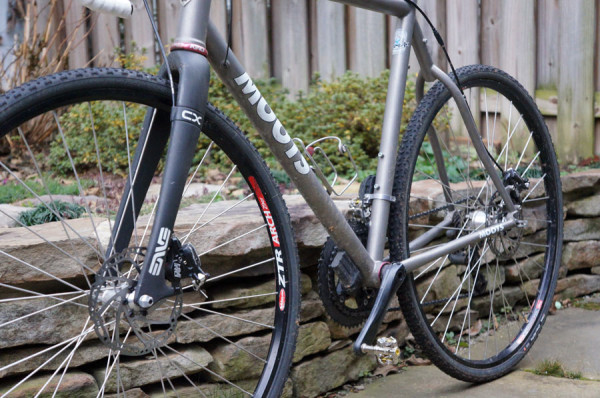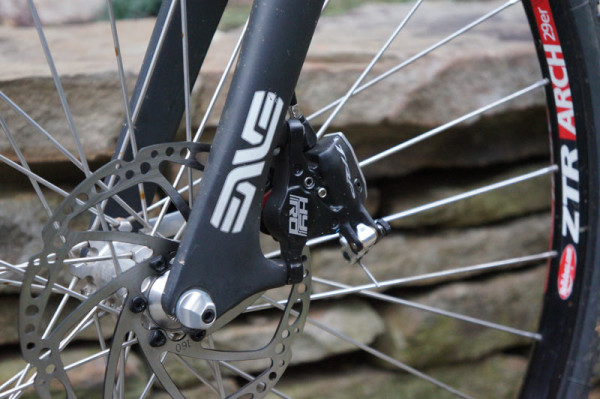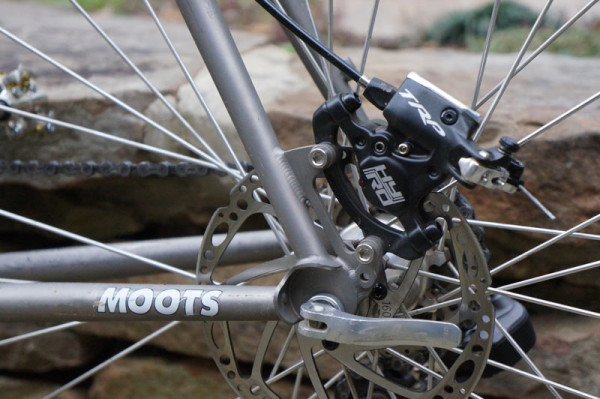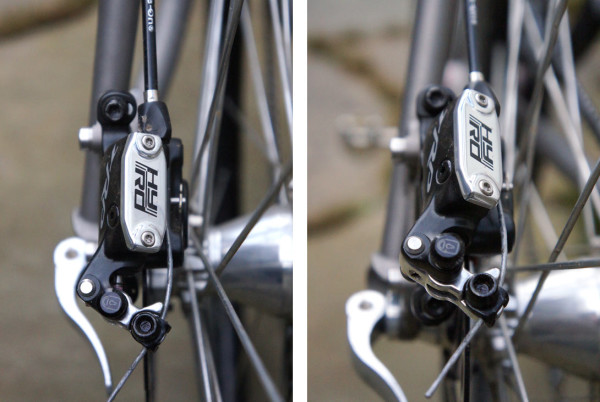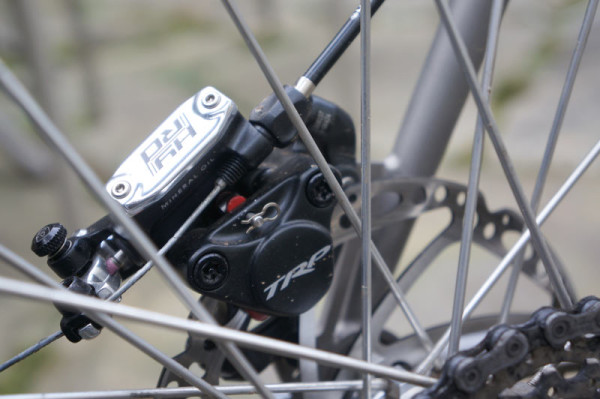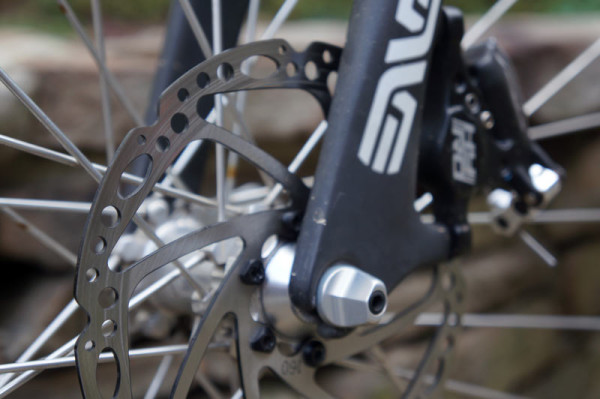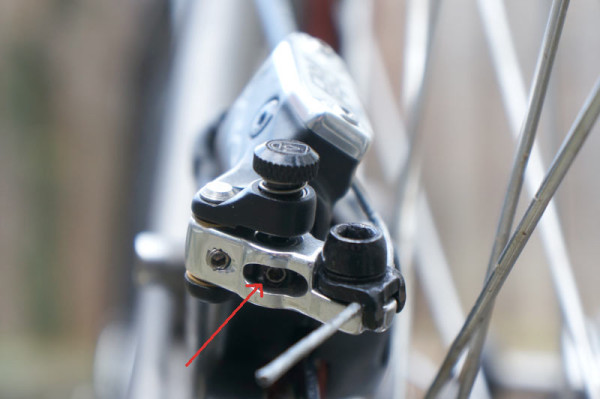Launched last April just as this whole disc brake road bike thing was starting to really take shape, TRP’s HY/RD (Hybrid Road) mechanical-to-hydraulic disc brake calipers aimed to combine the easy integration of mechanical brakes with the performance of a hydraulic. In theory, it’s the perfect add on for a bike that comes with a mechanical set up or if you’re just upgrading your frame and wheels and porting over your current group.
My first impressions (link above) were fairly good, but the layout of the demo bike at the launch left a bit to be desired. Once on my own bike (Moots Psychlo-X RSL), things got progressively better…
UNBOXED & WEIGHED
I picked up my test set directly from TRP at DealerCamp last summer, without the retail packaging. They’re available in black or chromed silver caliper bodies with 140mm or 160mm rotors and include IS to PM adapters. IS to IS adapters are available separately. The pad is a semi-metallic compound. Retail is $149.99 per wheel.
Both calipers came in at 190g (5g less than claimed weight) and a 160mm rotor is 108g. TRP recommends 160mm for the front, but I ran 160mm front and rear. I’m 6’2″ and 188lbs before kitting up, so I like the additional grab of the larger rear rotor.
TECH & DETAILS
The interior tech and functionality was covered in detail at the launch, so this is a brief recap. Essentially, the HY/RD puts the master cylinder directly on the caliper body, eliminating all the hose by using standard mechanical cables to connect it to your brake levers. That means it’s considerably bigger than other brakes, which may cause some fit concerns in the rear:
If your frame puts the brakes on the outside, you’ll likely be fine. If they mount inside the rear triangle, there are two things to look out for – cable stop/port placement on the frame and seatstay clearance. The latter is self explanatory, either the caliper clears the frame or it doesn’t. The former, cable placement, takes a bit more figuring out. You want the cable to exit the frame (if internal) or stop (external) far enough in front of the caliper to allow for a smooth, wide bend into the brake. Otherwise, you’ll end up with cable drag that’ll make them feel like poo.
The brakes work by pulling a lever, which pushes the push rod into the master cylinder. As it goes in, it closes the system and pushes fluid to the pistons, which push the pads toward the rotor. The bleed port is on the upper, outer side. Under the polished cap is a flexible diaphragm that allows for fluid expansion and contraction. So far, same as normal brakes.
Brake pads are pinned in place with a bolt that threads open to the outside of the unit.
The HY/RD-Spyre rotor works far better with them than their Dash rotors. When I got my test set, they were without rotors, so I installed the Dash rotors I had on hand from the Parabox. With those, there was a distinct pulsing, but once replaced with the proper rotors, performance was smoother and stronger. And I think these look better.
SET UP & REVIEW
Set up is extremely simple. Simply thread in the lock bolt to prevent the lever from moving, pull the cable as tight as humanly possible, clamp it down and you should be all set. With the lock bolt still holding the lever still, pull your brake levers – there should be zero movement. If there is, pull the cable tighter (the Park Tools BT-2 Cable Stretcher works wonders) and try again, or use the barrel adjuster to take up any slack. Once there’s absolutely no movement at the brake lever, they should be set. All in all, installation and set up should only take a few minutes if you have the right tools handy.
That said, even with my brake levers immobile with the lock bolt in place, I had too much lever throw once it was released. I could pull the lever (Shimano Ultegra Di2, first gen) to the bar and still not lock up the rear brake.
TRP makes it very clear that once set up, there should be no cable slack and you should not use the barrel adjuster to tighten up the brakes. And for good reason. By doing so, you can pull the pushrod in too far, making it so that even when released, the timing port remains closed. To work properly, a hydraulic brake needs the seal on the push rod to move behind the timing port when released. This equalizes the pressure of the oil between the pistons/hose and the master cylinder and allows for heat expansion. That’s what lets the pads fully retract and prevents them from closing down if things get too hot.
But, on my bike, they felt way too soft, so I used the allen key on the push rod to adjust the brake pressure. This has the same effect as dialing down the barrel adjuster and is a no-no. But, it made the brakes feel right, and it only took a minor amount of tweaking to get them dialed, so I went with it. I haven’t had any problems with them. That said, neither I nor TRP recommend you do this. More on that at the bottom. I mention it only because it’s highly unlikely I’m the only person that would try this.
The proper fix, according to TRP technical rep Dave Biehler, is to A) run the brakes for a longer period of time on test rides in non-safety-threatening situations to see if they’ll settle themselves up in the proper position, or B) add a bit more fluid to the system to push the pads in closer. That’s a job best left to the shop unless you have the proper TRP brake fluid and bleed kit. I haven’t tried that yet.
Dave says the initial feel will vary by set, and that some people like the softer feel and some like the harder, crisper performance I was seeking. There’s some degree of adjustment by altering fluid levels as mentioned, and lever placement and bar shape will affect how far you can pull them, too. Ultimately, if you can pull the levers to the bar and that prevents you from getting enough power, try the fixes above or try a different brake.
Now for the performance review. Assuming they’ll set up properly for you, you’re in luck. They feel magnificent.
For my first four or five rides, my general thoughts were “these feel pretty good, certainly better than mechanical brakes, but not quite as ‘pure’ feeling as a full hydraulic system.” But, as more rides passed and more braking occurred, the better they felt, inching closer and closer to a full hydraulic feel. I can’t say whether the piston seals were breaking in, the pads were becoming more accustomed to the rotor or some other magic, but they really did start feeling better the more I rode them. Since my time on full hydraulic road brake systems is pretty limited so far, I’ll equate them to a full hydro mountain bike brake this way: They’re about 90-95% there in terms of feel and power. Which is to say they’re worlds better than a full mechanical system.
I’ve ridden them in warm sunny weather, misting rain and sub-30º winter days, and the performance was solid in every instance. There was no brake squeal, either. They’ve been ridden extensively on the road and dirt/gravel paths as well as some cyclocross training and racing. If your set up doesn’t run into any of the caveats mentioned above, I’d say go for it.
Meanwhile, Rob purchased a set for his own bike. Here’s his thoughts:
ROB’S REVIEW
Having made the jump to disc brakes for the 2013 CX season I was somewhat disappointed with the performance from the stock cable disc brakes on my Fuji during the first really muddy race. I did not experience total brake failure like the guys at CX Nationals last season, but the drop off in performance during the race was noticable. Knowing how much nicer hydraulic disc brakes are on my mountain bike (than the canti brakes I started with many years ago), but not being able to afford some of the dedicated road hydraulic offings on the market the TRP HY/RD brakes seemed like the perfect option. I was somewhat skeptical about TRP since I had never tried their hydraulic brakes before. My only previous experience with TRP had been with their road brakes on a demo bike a few years ago. However, I decided to take the leap and try them out for the remainder of the season. I am glad I did because not only are they powerful, easy to set up and easier to modulate, they just flat out work in all conditions.
Are these brakes perfect? Pretty close, but they could be made a little lighter and maybe have a slightly different leverage ratio. They tend to work best with new Shimano levers due to the longer cable pull, but I have also used them with levers from SRAM, older Shimano and Campagnolo as well. The TRP HY/RD brakes work fine with all of these, but be aware the lever pulls closer to the handlebar during hard braking. As with all mechanical disc brakes the use of compression-less housing is strongly advised. I had the best luck using the Yokozuna cables and housing.
Final verdict: These brakes are awesome! Can Stop, Will Stop!!
TO BE CONTINUED…
So, what’s all this about a “Part One”? Two things: First, I (Tyler) want more time on them for proper long term testing, which will include some bigger descents. Second, Dave mentioned they’ve refined the design a bit, putting a stop screw on the pushrod adjustment to prevent people from doing exactly what I did, and should we get a set of the new ones, we’ll sub those in and start accumulating miles.
